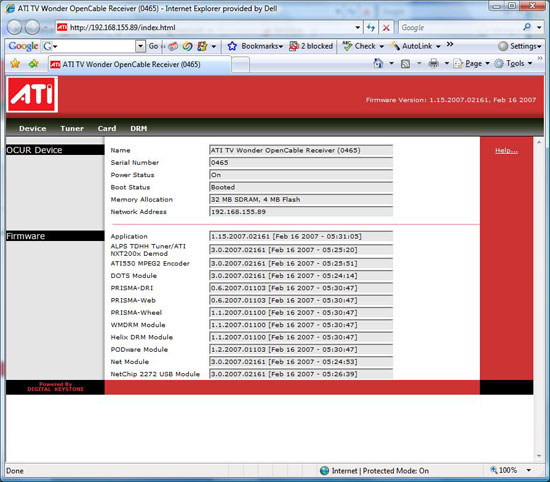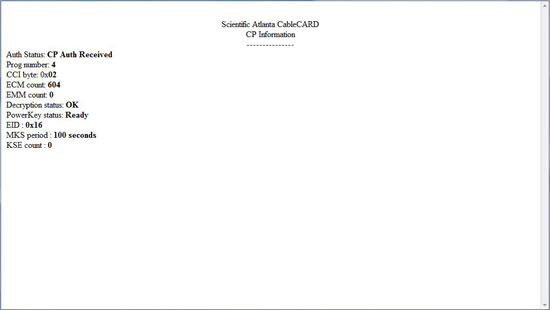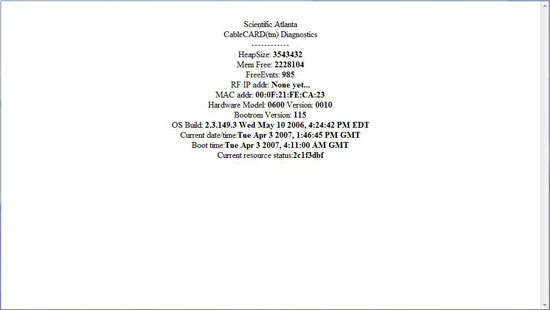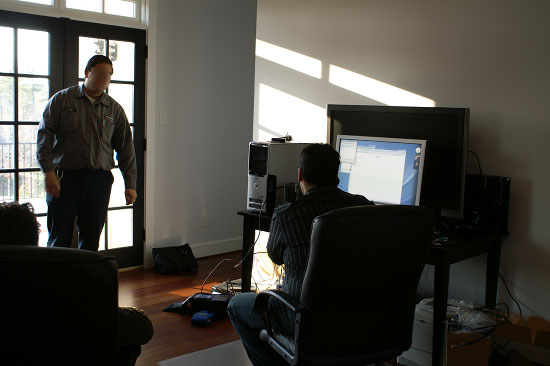ATI TV Wonder Digital Cable Tuner: AMD and Dell Bring CableCARD to PCs
by Anand Lal Shimpi on April 3, 2007 11:37 AM EST- Posted in
- GPUs
The Installation: Day One
Prior to Dell's arrival we had a handful of telephone conversations and email exchanges to clear our intentions for this article. Dell is used to dealing with sending review samples of complete systems that it has built and tested time and time again. Dell was not used to sending a platform out that was buggy, not yet ready for prime time and dependent on a cable network that it had absolutely no control over. In short: Dell was nervous.
Dell asked us if it was alright if a handful of representatives accompanied the system to our office in North Carolina, just to make sure things went smoothly. We didn't anticipate any problems but said that if it made them feel more comfortable, they were welcome to oversee the initial setup. From our perspective the setup couldn't be simpler: 1) Setup the system, 2) Insert CableCARD, 3) Watch TV. It turned out that we were a bit optimistic.
Even though it had been over a year since we first saw OCUR demoed, the devices and platform as a whole weren't perfect. The problem is that proper operation depends on far more than just a piece of hardware and its associated driver. With OCUR, you have the usual hardware and software problems, but then you've got issues with wiring at the location. Is the signal coming to the coax port sufficient for OCUR? We found that what was sufficient for a Scientific Atlanta HD-DVR wasn't necessarily enough for proper OCUR operation. Then there are issues with the actual cable network the device is running on. Each cable network is slightly different and we found that these devices don't always behave similarly across different networks. Then there's Dell, a company that at best can only control how the system was built and what hardware went into it; a company that was tasked with taking the brunt of any problems that crept up at ground zero when we set up the OCUR system.
Dell came prepared; upon landing at RDU International Airport, we got a call asking if it was okay if a Time Warner technician was present during the install to help with any problems. The more the merrier we thought, so Dell made a phone call and a Time Warner technician was present. As a side note, the last line was exactly how it happened. Apparently the magic number Dell called dispatched a Time Warner technician to what is known internally as a "VIP Customer". There were no vague time windows, no waiting, and no arguing; just a phone call and poof: instant technician. After discovering this magic ability that Dell possessed, we asked Dell to move in with us permanently. Regrettably Dell declined and its representatives did not confirm whether or not they had similar influence over the local phone or utility companies.

When you're Dell, TWC comes with lights and sirens blaring
For the first part of the setup, Dell was quite ambitious. Gary Lusk from Dell was the resident performance engineer on site (aside from yours truly), and he had hand carried two ATI TV Wonder Digital Cable Tuners with him from Austin. Figuring that nothing could go wrong, he confidently hooked up both tuners and began the configuration process. Both tuners required a firmware update provided by AMD; however that won't be a step that end users will have to worry about once these things make their public appearance.

The TV Wonder DCTs appear as Network devices
The tuners were detected by Vista, which has a built in driver for them. As a side note, Microsoft (not AMD) wrote the Vista driver for the TV Wonder DCT, so any driver bugs are actually Microsoft's responsibility and not AMD's. Each OCUR device actually appears as a Network device in Vista. Each OCUR has its own IP address, which if you visit in a web browser you get a configuration website served from the OCUR. The configuration pages give you the necessary information that your cable provider will need to activate your CableCARD(s); however, this information is also accessible through Vista's media center interface. The configuration pages are a bit more robust and will let you do much more, but in theory you shouldn't have to toy with any of the options.




Dell had requested that we have a CableCARD ready upon their arrival, so we called up Time Warner and had them activate a single CableCARD on a TV with hopes that it would speed up the entire process. Activating CableCARD is far more painful than it should be in our opinion. Time Warner, like many cable providers, doesn't offer a self-install option for CableCARD in the Raleigh area. We also weren't able to order CableCARD online; we had to call up Time Warner and request a CableCARD which would be installed by one of its technicians.
Upon asking for a CableCARD, the TWC representative informed us of a few things. CableCARDs aren't available for self install, it usually takes about 3 days to get one in after the order has been placed, and the installer would be available after then. We were then warned that features like On Demand and the program guide would not be available with CableCARD. The rep asked us what the make and model number of the TV was that we would need the CableCARD for and how many cards we needed. The monthly fee was $1.99 per CableCARD with a one time installation fee of $42.95. We felt the installation fee was a bit ridiculous given that the installation consists of sliding the CableCARD into the slot and calling Time Warner with the Host ID and MAC address of the CableCARD to activate it. We'd hope that at some point a self-install process can be developed, but until then this is the only option.
After Time Warner activates the CableCARD on its end, there's a period of time before the CableCARD will actually give you access to your content. During this period you (or the technician on site) are told to simply watch the EMM count increment, generally until it reaches some arbitrary value that determines when you get digital cable access. We went through the process with Time Warner on the TV and it worked flawlessly; when Dell arrived a couple of weeks later, we simply took the CableCARD out of the TV and stuck it in one of the TV Wonder DCTs.

TWC tech on the left watching Dell's Gary on the right talk to a TWC tech on the phone
Despite working flawlessly in the TV, after sticking the CableCARD in one of the DCTs we could not tune to any digital cable - much less HDTV - channels. At best all we got were analog SD channels. We went through the hardware setup several times with Dell and weren't able to fix the problem. Time Warner stepped in and tried fixing the issue on its end, once again to no avail. In a particularly hilarious moment, the Time Warner technician on site passed the phone to Gary Lusk of Dell to work with another Time Warner tech on the phone. The first day ended in a series of failed attempts, Dell extended its stay in sunny North Carolina, and we vowed to try again tomorrow. This time we would have AMD, Microsoft, and more Time Warner folks on call.










29 Comments
View All Comments
n7 - Wednesday, April 4, 2007 - link
I am amazed at how restricted this is.I was looking forward to the day when i could get a tuner capable of high def support to add to my PC.
And now i see that the once again, the consumers are basically getting royally ******.
I'm incredibly disapppointed.
Thanx very much for this article though...does an excellent job of showing just how retarded DRM has become...
Cygni - Tuesday, April 3, 2007 - link
Thank you for this article Anand. When you first reviewed Vista, i asked for a review of its MCE component, to which you replied such an article was comming. I was beginning to think you forgot about writing that article! :DI am in the shrinking majority of non HDTV owners. I have a 32in Sony CRT TV that ive had for at least 10 years. Its still one of the best looking TV's around, in my opinion. I use MCE to function as a recorder so that I dont have to pay a monthly fee to anyone. I feel thats ridiculous. I bought a $50 ATI TV card and with MCE, can do everything a TIVO can, AND save money, AND burn what programing i want and give it to who i want.
I have one big question i wanted to ask, however. Did you try Vista Media Centers multi screen performance? I use Svideo to connect my TV and computer, and i enjoy working on one screen while having MCE going in the other. However, MCE 2k5's performance in this situation is pretty bad, and the MCE team itself admitted that they hadnt thought of this scenario.
feraltoad - Tuesday, April 3, 2007 - link
So let me get this straight the ONLY people that really want OCUR (people with media center PCs) will be the ones that can't get it? WTH! Bad enough you need HDCP monitors and Video cards, but even when you do upgrade everything it still won't be enough until you buy a ready made box (and if you have a HTPC that is used as a Media PC then it is probably DIY). So the people that this things is going to marketed to will be people that 1)Have no idea it exists 2)Don't/Won't want it 3)Apparently will be better served to pay $10 a month to rent something that will "just work". I have a MCE2005 pc, and it looks pretty obvious which way the wind is blowing: HD-DVR here I come.Also, besides a rant I had a question. What if you have ONE HDCP compliant monitor(HDTV) and one non HDCP LCD (that doesn't merit replacement yet). Will it still work and let you play the content on the TV? Or will the non hdcp monitor "break" the compliance and thus the functionality.
thestain - Wednesday, April 4, 2007 - link
AMD's kissing Microsofts rear is a recipe for an american made disaster.Is there no hardware company that is willing to give customers ownership of the hardware they buy anymore??
AMD/Daamit would do better getting the cpus and gpus out that have been delayed and delayed.. or nVidia and Intel will destroy AMD.
Wolfpup - Tuesday, April 3, 2007 - link
That wasn't mentioned in the article. In two years I'll have to get some sort of ATSC replacement for my NTSC-only S2 Tivo.Also-is this for real that you can't burn real DVDs with this setup? I presume that means you can't even copy files to another computer to watch (only stream them to a 360)?
In that case this doesn't work for me. Hope there are more ATSC solutions available by the time I need them...
Smilin - Tuesday, April 3, 2007 - link
Your #1 mistake was activating the card on a different device first. This caused you major problems. The mating of the card to a particular device is not a time-warner only thing. Had you not made this pretty dumb move you wouldn't have had Dell, ATI and Time Warner dancing around like monkeys for so many days.The problem switching between SD and HD is most likely a server issue at the cable company. Unfortunately "that guy" who is smart enough to fix it is so far up the food chain you'll never reach him through the mass of standard techs.
How do I know this? Go check out the Support forums over at Tivo. The problems are everywhere. The series 3 has dual cable cards and guess what? Cable companies give it fits. In every case the cable company will push back and say it's a problem with your device. In every case this turns out not to be true.
I ran into many of the issues you are seeing with my Series 3 Tivo. After like 4 cable cards, 5 trips from techs, pulling my hair until I was bald I finally got "the guy" who said it was merely a server issue on their end. No problems since.
mwales - Tuesday, April 3, 2007 - link
So as a Kubuntu Linux user, on a PC built from parts, and "soon to be owner" of a PS3, I feel a little left out of the party. Seriously, the amount of restrictions for a system to do this is ridiculous and makes me want to vomit.I happen to have a Windows XP running Beyond TV DVR software (it's NTSC only unfortunately). But I'm able to share my media folder and access it from Windows PCs, Linux PCs, and even both XBox systems when they run XBox Media Center. It works FANTASTIC! Even my wife can stream content and watch it on an XBox without any issues or help. Once I get a Creative Vision M, I can easily move my non-DRM files unencumbered to my portable video player. I'm also able to burn DVDs of shows I really enjoyed so I can watch them later on my DVD/DivX player.
DigitalFreak - Tuesday, April 3, 2007 - link
As long as the content providers are allowed to dictate how and where we watch their content, these products will always be a pain in the ass to setup and use.Still waiting on the CES 2006 announced DirecTV / MCE tuners.
michal1980 - Tuesday, April 3, 2007 - link
i'd get that 4000 grand pc if it came with all the techs to help set it up.cable card needs bi-directional support before it gets my vote though.
BPB - Tuesday, April 3, 2007 - link
This article was not at all interesting for me personally. Oh, the tech end of it was, and the fact that AMD/MS/Hollywood/the cable industry can't work well as a group was interesting. But since the technology itself is not available to me unless I buy an expensicve Dell (or equivalent), I really don't care about it. I'll continue to go along using my Cox HD-DVR and be happy. Actually, if I do want to do something like this I'll simply rent a Cox HD cable box and plug it into my ATI 650 based tuner card (which has HD support) or my X1900 AIW (which accepts HD input). So for the price of the Cox rental I can have HD on my PC, and for far less money. Then again, the way MS and the cable industry are going, I can't be sure that would work. Oh well, guess I'll have to continue using the Firewire out on my HD-DVR to copy movies to my wife's notebook, then my desktop. It's a pain, but it's cheap and easy. My dad's new HD-DVR is also a cable modem. I wonder if it can be networked? Wouldn't that be nice?